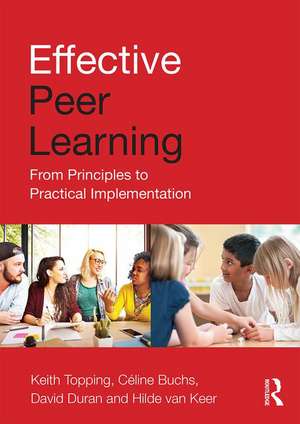Effective Peer Learning: From Principles to Practical Implementation
Autor Keith Topping, Céline Buchs, David Duran, Hilde van Keeren Limba Engleză Paperback – 27 mar 2017
The aim of this book is to help practitioners establish well-structured and effective peer learning projects using a variety of methods. It introduces and defines cooperative learning (mutual peer interaction) and peer tutoring (directional peer interaction) – outlining general organisational principles that will help practitioners implement peer learning in either of these forms. The authors consider how to prepare and train learners to undertake their roles effectively, and how to organise and monitor the process of interaction as it is happening. They then look at how these systems actually operate in the classroom, exploring how the organisational principles work in practice and giving many practical examples. Subsequently three successive chapters consider how to structure peer interactions in cooperative learning, same-age peer tutoring and cross-age peer tutoring. Finally, the advantages and problems, and the potential and challenges, of peer learning are examined.
The book should be read in stages, with each part being able to be read on its own – thus providing time for reflection. Within each part, readers can choose to focus on cooperative learning or peer tutoring. The successive focuses on definitions, general principles of implementation and practical issues of implementation should help practitioners build their skills and confidence. Many choices between methods are described, and when teachers are confident in one method they may then consider trying a new method. It is the authors' hope that the book will become a model for peer learning by sharing with readers the skills of other practitioners, and thereby helping all children to develop to their full potential.
| Toate formatele și edițiile | Preț | Express |
|---|---|---|
| Paperback (1) | 399.41 lei 43-57 zile | |
| Taylor & Francis – 27 mar 2017 | 399.41 lei 43-57 zile | |
| Hardback (1) | 709.78 lei 43-57 zile | |
| Taylor & Francis – 27 mar 2017 | 709.78 lei 43-57 zile |
Preț: 399.41 lei
Nou
Puncte Express: 599
Preț estimativ în valută:
76.45€ • 83.07$ • 64.26£
76.45€ • 83.07$ • 64.26£
Carte tipărită la comandă
Livrare economică 21 aprilie-05 mai
Preluare comenzi: 021 569.72.76
Specificații
ISBN-13: 9781138906495
ISBN-10: 1138906492
Pagini: 192
Ilustrații: 32 Tables, black and white; 4 Illustrations, black and white
Dimensiuni: 174 x 246 x 15 mm
Greutate: 0.38 kg
Ediția:1
Editura: Taylor & Francis
Colecția Routledge
Locul publicării:Oxford, United Kingdom
ISBN-10: 1138906492
Pagini: 192
Ilustrații: 32 Tables, black and white; 4 Illustrations, black and white
Dimensiuni: 174 x 246 x 15 mm
Greutate: 0.38 kg
Ediția:1
Editura: Taylor & Francis
Colecția Routledge
Locul publicării:Oxford, United Kingdom
Public țintă
Professional and UndergraduateCuprins
Part I. Introducing peer learning
1. Mutual peer interactions
2. Peer learning: directional peer interactions
Part II. General principles for peer learning
3. Preparing learners for constructive interactions
4. Organising peer interactions in academic tasks
Part III. Practical propositions for the classroom
5. Structuring peer interactions in symmetrical relationships (cooperative learning)
6. Structuring directional peer interactions in same-age tutoring
7. Structuring directional peer interactions in cross-age tutoring
Part IV. Conclusions and onward directions
8. Advantages, problems, potential and challenges of peer learning
References
1. Mutual peer interactions
2. Peer learning: directional peer interactions
Part II. General principles for peer learning
3. Preparing learners for constructive interactions
4. Organising peer interactions in academic tasks
Part III. Practical propositions for the classroom
5. Structuring peer interactions in symmetrical relationships (cooperative learning)
6. Structuring directional peer interactions in same-age tutoring
7. Structuring directional peer interactions in cross-age tutoring
Part IV. Conclusions and onward directions
8. Advantages, problems, potential and challenges of peer learning
References
Notă biografică
Keith Topping, School of Education, University of Dundee, UK.
Céline Buchs, University of Geneva, Switzerland.
David Duran, Department of Psychology of Education, Universitat Autònoma de Barcelona, Spain.
Hilde van Keer, Department of Educational Studies, Ghent University, Belgium.
Céline Buchs, University of Geneva, Switzerland.
David Duran, Department of Psychology of Education, Universitat Autònoma de Barcelona, Spain.
Hilde van Keer, Department of Educational Studies, Ghent University, Belgium.
Recenzii
A guide that aims to help practitioners establish well-structured and effective peer learning projects using a variety of methods…Highly recommended for a wide variety of audiences: from those educational professionals who want to start using cooperative learning at any educational stage, to those who already use it and want to improve their practices, and even for those who are not convinced about is application in the classroom yet. - Revista de Educación 379, Jan-March 2018
Descriere
Peer learning allows a positive use of differences between pupils, turning them into learning opportunities. Yet education professionals often remain unfamiliar with the principles to guarantee its effectiveness. An Introduction to Peer Learning offers a guide, underpinned by the latest theory and research in the field, to structuring student interactions in the classroom in order to promote learning. Illustrated with models of successful practice from diverse schools across Europe, it provides the background to the different types of peer learning, explores the importance of preparing the environment and structuring tasks, and unpacks practical considerations for teachers in the classrooms.
